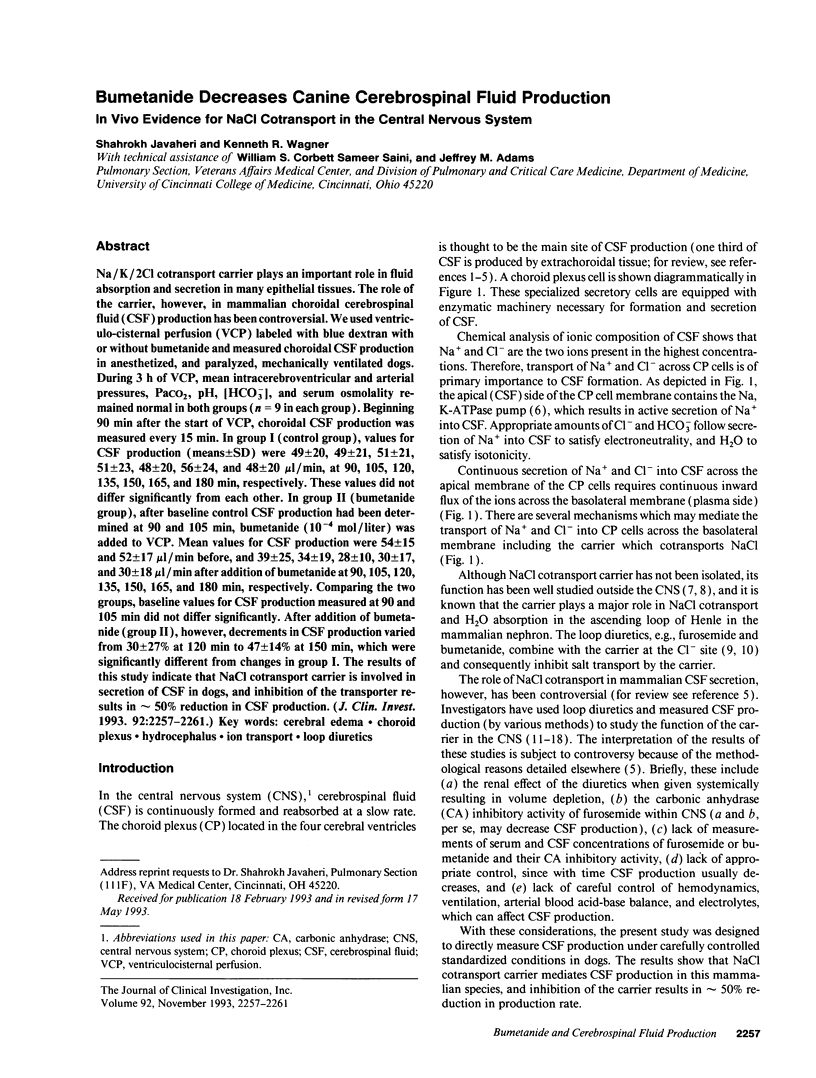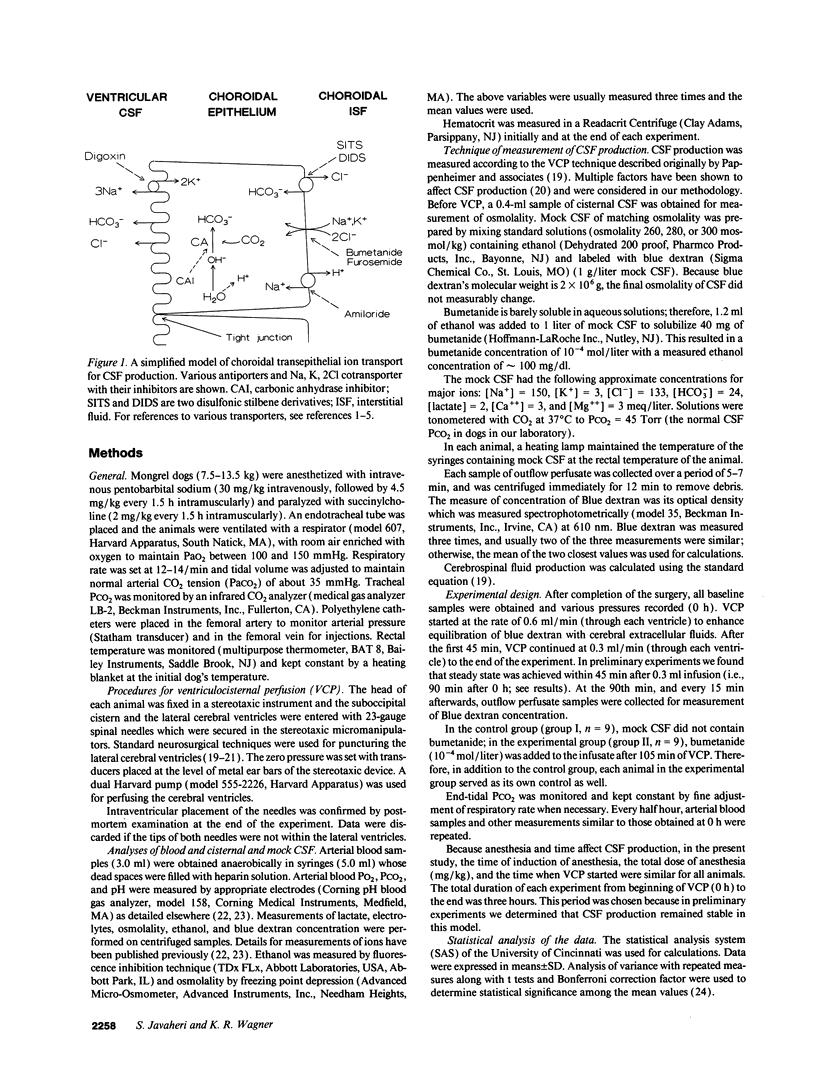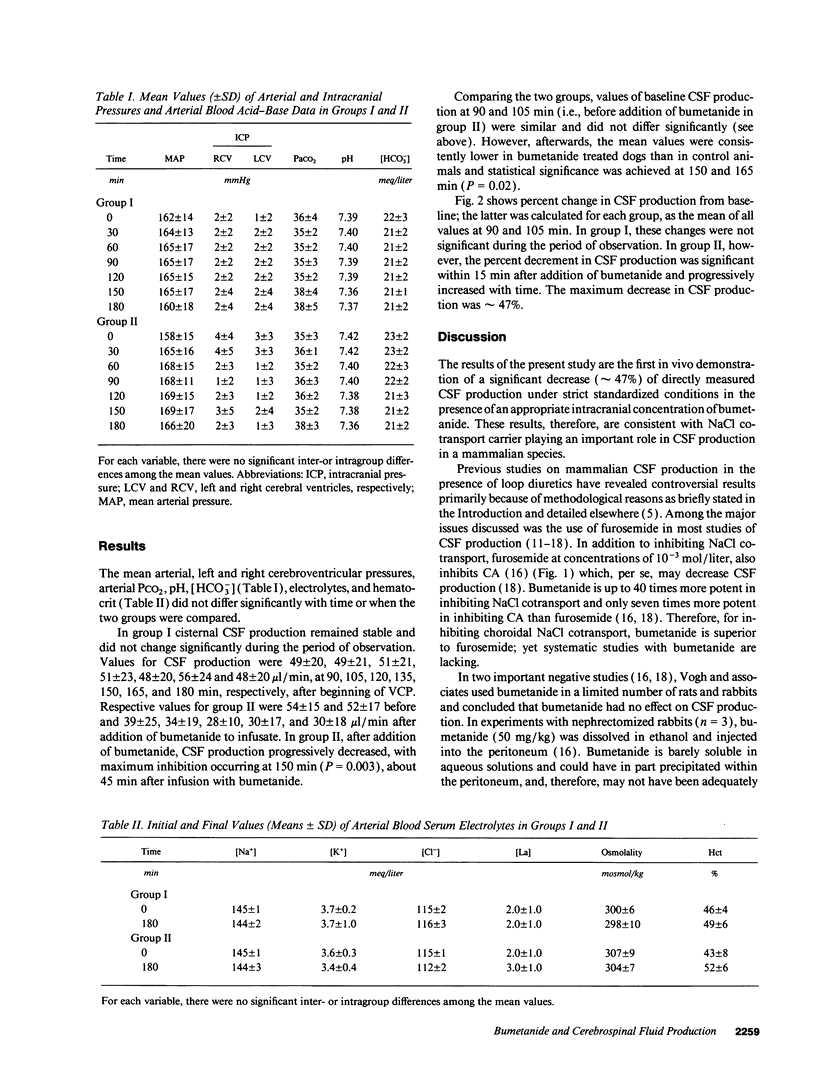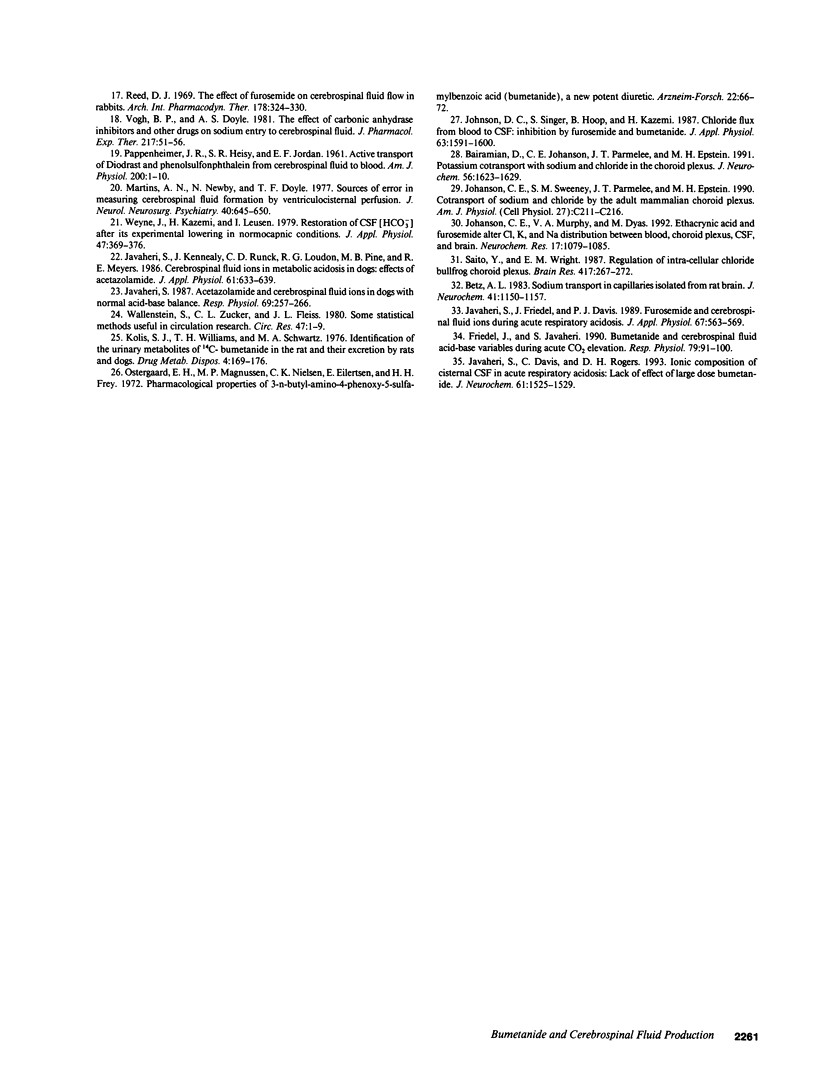Abstract
Na/K/2Cl cotransport carrier plays an important role in fluid absorption and secretion in many epithelial tissues. The role of the carrier, however, in mammalian choroidal cerebrospinal fluid (CSF) production has been controversial. We used ventriculo-cisternal perfusion (VCP) labeled with blue dextran with or without bumetanide and measured choroidal CSF production in anesthetized, and paralyzed, mechanically ventilated dogs. During 3 h of VCP, mean intracerebroventricular and arterial pressures, PaCO2, pH, [HCO3-], and serum osmolality remained normal in both groups (n = 9 in each group). Beginning 90 min after the start of VCP, choroidal CSF production was measured every 15 min. In group I (control group), values for CSF production (means +/- SD) were 49 +/- 20, 49 +/- 21, 51 +/- 21, 51 +/- 23, 48 +/- 20, 56 +/- 24, and 48 +/- 20 microliters/min, at 90, 105, 120, 135, 150, 165, and 180 min, respectively. These values did not differ significantly from each other. In group II (bumetanide group), after baseline control CSF production had been determined at 90 and 105 min, bumetanide (10(-4) mol/liter) was added to VCP. Mean values for CSF production were 54 +/- 15 and 52 +/- 17 microliters/min before, and 39 +/- 25, 34 +/- 19, 28 +/- 10, 30 +/- 17, and 30 +/- 18 microliters/min after addition of bumetanide at 90, 105, 120, 135, 150, 165, and 180 min, respectively. Comparing the two groups, baseline values for CSF production measured at 90 and 105 min did not differ significantly. After addition of bumetanide (group II), however, decrements in CSF production varied from 30 +/- 27% at 120 min to 47 +/- 14% at 150 min, which were significantly different from changes in group I. The results of this study indicate that NaCl cotransport carrier is involved in secretion of CSF in dogs, and inhibition of the transporter results in approximately 50% reduction in CSF production.
Full text
PDF




Selected References
These references are in PubMed. This may not be the complete list of references from this article.
- Bairamian D., Johanson C. E., Parmelee J. T., Epstein M. H. Potassium cotransport with sodium and chloride in the choroid plexus. J Neurochem. 1991 May;56(5):1623–1629. doi: 10.1111/j.1471-4159.1991.tb02060.x. [DOI] [PubMed] [Google Scholar]
- Betz A. L. Sodium transport in capillaries isolated from rat brain. J Neurochem. 1983 Oct;41(4):1150–1157. doi: 10.1111/j.1471-4159.1983.tb09065.x. [DOI] [PubMed] [Google Scholar]
- Domer F. R. Effects of diuretics on cerebrospinal fluid formation and potassium movement. Exp Neurol. 1969 May;24(1):54–64. doi: 10.1016/0014-4886(69)90005-3. [DOI] [PubMed] [Google Scholar]
- Freidel J. F., Javaheri S. Bumetanide and cerebrospinal fluid acid-base variables during acute CO2 elevation. Respir Physiol. 1990 Jan;79(1):91–100. doi: 10.1016/0034-5687(90)90063-5. [DOI] [PubMed] [Google Scholar]
- Frizzell R. A., Field M., Schultz S. G. Sodium-coupled chloride transport by epithelial tissues. Am J Physiol. 1979 Jan;236(1):F1–F8. doi: 10.1152/ajprenal.1979.236.1.F1. [DOI] [PubMed] [Google Scholar]
- Haas M., Forbush B., 3rd [3H]bumetanide binding to duck red cells. Correlation with inhibition of (Na + K + 2Cl) co-transport. J Biol Chem. 1986 Jun 25;261(18):8434–8441. [PubMed] [Google Scholar]
- Haas M., McManus T. J. Bumetanide inhibits (Na + K + 2Cl) co-transport at a chloride site. Am J Physiol. 1983 Sep;245(3):C235–C240. doi: 10.1152/ajpcell.1983.245.3.C235. [DOI] [PubMed] [Google Scholar]
- Javaheri S. Acetazolamide and cerebrospinal fluid ions in dogs with normal acid-base balance. Respir Physiol. 1987 Aug;69(2):257–266. doi: 10.1016/0034-5687(87)90032-6. [DOI] [PubMed] [Google Scholar]
- Javaheri S., Davis C., Rogers D. H. Ionic composition of cisternal CSF in acute respiratory acidosis: lack of effect of large dose bumetanide. J Neurochem. 1993 Oct;61(4):1525–1529. doi: 10.1111/j.1471-4159.1993.tb13648.x. [DOI] [PubMed] [Google Scholar]
- Javaheri S., Freidel J. F., Davis P. J. Furosemide and cerebrospinal fluid ions during acute respiratory acidosis. J Appl Physiol (1985) 1989 Aug;67(2):563–569. doi: 10.1152/jappl.1989.67.2.563. [DOI] [PubMed] [Google Scholar]
- Javaheri S., Kennealy J., Runck C. D., Loudon R. G., Pine M. B., Myers R. E. Cerebrospinal fluid ions in metabolic acidosis in dogs: effects of acetazolamide. J Appl Physiol (1985) 1986 Aug;61(2):633–639. doi: 10.1152/jappl.1986.61.2.633. [DOI] [PubMed] [Google Scholar]
- Javaheri S. Role of NaCl cotransport in cerebrospinal fluid production: effects of loop diuretics. J Appl Physiol (1985) 1991 Sep;71(3):795–800. doi: 10.1152/jappl.1991.71.3.795. [DOI] [PubMed] [Google Scholar]
- Johanson C. E., Murphy V. A., Dyas M. Ethacrynic acid and furosemide alter Cl, K, and Na distribution between blood, choroid plexus, CSF, and brain. Neurochem Res. 1992 Nov;17(11):1079–1085. doi: 10.1007/BF00967284. [DOI] [PubMed] [Google Scholar]
- Johanson C. E., Sweeney S. M., Parmelee J. T., Epstein M. H. Cotransport of sodium and chloride by the adult mammalian choroid plexus. Am J Physiol. 1990 Feb;258(2 Pt 1):C211–C216. doi: 10.1152/ajpcell.1990.258.2.C211. [DOI] [PubMed] [Google Scholar]
- Johnson D. C., Singer S., Hoop B., Kazemi H. Chloride flux from blood to CSF: inhibition by furosemide and bumetanide. J Appl Physiol (1985) 1987 Oct;63(4):1591–1600. doi: 10.1152/jappl.1987.63.4.1591. [DOI] [PubMed] [Google Scholar]
- Kazemi H., Johnson D. C. Regulation of cerebrospinal fluid acid-base balance. Physiol Rev. 1986 Oct;66(4):953–1037. doi: 10.1152/physrev.1986.66.4.953. [DOI] [PubMed] [Google Scholar]
- Kolis S. J., Williams T. H., Schwartz M. A. Identification of the urinary metabolites of 14C-bumetanide in the rat and their excretion by rats and dogs. Drug Metab Dispos. 1976 Mar-Apr;4(2):169–176. [PubMed] [Google Scholar]
- Lauf P. K., McManus T. J., Haas M., Forbush B., 3rd, Duhm J., Flatman P. W., Saier M. H., Jr, Russell J. M. Physiology and biophysics of chloride and cation cotransport across cell membranes. Fed Proc. 1987 May 15;46(7):2377–2394. [PubMed] [Google Scholar]
- Martins A. N., Newby N., Doyle T. F. Sources of error in measuring cerebrospinal fluid formation by ventriculocisternal perfusion. J Neurol Neurosurg Psychiatry. 1977 Jul;40(7):645–650. doi: 10.1136/jnnp.40.7.645. [DOI] [PMC free article] [PubMed] [Google Scholar]
- McCarthy K. D., Reed D. J. The effect of acetazolamide and furosemide on cerebrospinal fluid production and choroid plexus carbonic anhydrase activity. J Pharmacol Exp Ther. 1974 Apr;189(1):194–201. [PubMed] [Google Scholar]
- Melby J. M., Miner L. C., Reed D. J. Effect of acetazolamide and furosemide on the production and composition of cerebrospinal fluid from the cat choroid plexus. Can J Physiol Pharmacol. 1982 Mar;60(3):405–409. doi: 10.1139/y82-059. [DOI] [PubMed] [Google Scholar]
- Miller T. B., Wilkinson H. A., Rosenfeld S. A., Furuta T. Intracranial hypertension and cerebrospinal fluid production in dogs: effects of furosemide. Exp Neurol. 1986 Oct;94(1):66–80. doi: 10.1016/0014-4886(86)90272-4. [DOI] [PubMed] [Google Scholar]
- Ostergaard E. H., Magnussen M. P., Nielsen C. K., Eilertsen E., Frey H. H. Pharmacological properties of 3-n-butylamino-4-phenoxy-5-sulfamylbenzoic acid (Bumetanide), a new potent diuretic. Arzneimittelforschung. 1972 Jan;22(1):66–72. [PubMed] [Google Scholar]
- PAPPENHEIMER J. R., HEISEY S. R., JORDAN E. F. Active transport of Diodrast and phenolsulfonphthalein from cerebrospinal fluid to blood. Am J Physiol. 1961 Jan;200:1–10. doi: 10.1152/ajplegacy.1961.200.1.1. [DOI] [PubMed] [Google Scholar]
- Quinton P. M., Wright E. M., Tormey J. M. Localization of sodium pumps in the choroid plexus epithelium. J Cell Biol. 1973 Sep;58(3):724–730. doi: 10.1083/jcb.58.3.724. [DOI] [PMC free article] [PubMed] [Google Scholar]
- Reed D. J. The effect of furosemide on cerebrospinal fluid flow in rabbits. Arch Int Pharmacodyn Ther. 1969 Apr;178(2):324–330. [PubMed] [Google Scholar]
- Sahar A., Tsipstein E. Effects of mannitol and furosemide on the rate of formation of cerebrospinal fluid. Exp Neurol. 1978 Jul;60(3):584–591. doi: 10.1016/0014-4886(78)90012-2. [DOI] [PubMed] [Google Scholar]
- Saito Y., Wright E. M. Regulation of intracellular chloride in bullfrog choroid plexus. Brain Res. 1987 Aug 11;417(2):267–272. doi: 10.1016/0006-8993(87)90451-3. [DOI] [PubMed] [Google Scholar]
- Vogh B. P., Doyle A. S. The effect of carbonic anhydrase inhibitors and other drugs on sodium entry to cerebrospinal fluid. J Pharmacol Exp Ther. 1981 Apr;217(1):51–56. [PubMed] [Google Scholar]
- Vogh B. P., Langham M. R., Jr The effect of furosemide and bumetanide on cerebrospinal fluid formation. Brain Res. 1981 Sep 21;221(1):171–183. doi: 10.1016/0006-8993(81)91071-4. [DOI] [PubMed] [Google Scholar]
- Wallenstein S., Zucker C. L., Fleiss J. L. Some statistical methods useful in circulation research. Circ Res. 1980 Jul;47(1):1–9. doi: 10.1161/01.res.47.1.1. [DOI] [PubMed] [Google Scholar]
- Weyne J., Kazemi H., Leusen I. Restoration of CSF [HCO3-] after its experimental lowering in normocapnic conditions. J Appl Physiol Respir Environ Exerc Physiol. 1979 Aug;47(2):369–376. doi: 10.1152/jappl.1979.47.2.369. [DOI] [PubMed] [Google Scholar]
- Wright E. M. Transport processes in the formation of the cerebrospinal fluid. Rev Physiol Biochem Pharmacol. 1978;83:3–34. [PubMed] [Google Scholar]


